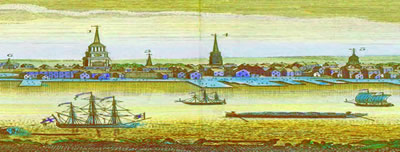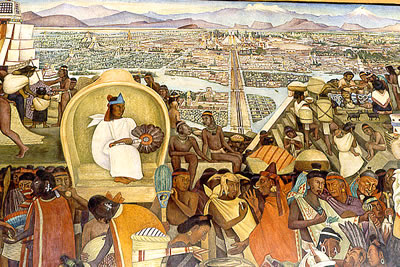 |
| British North America |
Italian merchant
John Cabot’s 1497 voyage from England west to what is now Newfoundland, Canada, was Europe’s first contact with North America since the Vikings. Cabot’s feat intensified English attention to the New World, yet for more than a hundred years, England would trail Spain and other European nations in exploring and exploiting the hemisphere. By 1750, however, Britain, having overcome a multitude of political, religious, and economic crises, was poised to dominate North America.
Early Undertakings During the reign of
Queen Elizabeth I, two efforts to establish English colonies in America ended in failure and death. In 1582, Sir Humphrey Gilbert personally led a large crew across the Atlantic to reclaim Cabot’s Newfoundland for the queen. Its unfavorable climate and competition from Spanish and Portuguese fishermen dampened Gilbert’s hopes. On the voyage home less than a year later, Gilbert perished in an Azores storm.
Somewhat more successful was
Sir Walter Raleigh, Gilbert’s half brother, and, for a time, a court favorite. Raleigh mounted a new colonial project in 1585, sending five ships bearing a hundred colonists to Roanoke Island, off the North Carolina coast.
When these settlers abandoned their mission in 1586, a second group was shipped to Roanoke, including the parents of Virginia Dare, who was, in 1587, the first English child born in North America. By 1590, a series of reprovisioning and rescue missions were reporting that the colony had disappeared, leaving generations of historians to argue whether Indian warfare, internal clashes, famine, disease, or some combination of these had wiped out Raleigh’s colonial ambitions.
As the 17th century dawned, England, despite its 1588 defeat of the
Spanish Armada, followed by other triumphs over Spain, was still scarcely a presence in North America. At home, rapid population growth and policies that forced subsistence farmers off the land, combined with Reformation-fueled religious conflicts, were creating both crisis and opportunity.
British colonization in America emerged as a patchwork process that sent royal courtiers, London investors, religious dissident families, and the desperately poor across the
Atlantic in search of profits and new hope.
Colonial “Plantation” Before 1660 Britain’s eventual dominion in eastern North America started unpromisingly in 1607 when
Jamestown was founded in the region Raleigh had earlier named “Virginia” for Elizabeth I, the presumed “Virgin Queen.”
Disciplinary measures imposed by soldier-adventurer John Smith, followed by John Rolfe’s 1614 introduction of
tobacco cultivation, eventually saved Jamestown, although major crises continued. Finding capable colonists in this wild and dangerous land remained difficult; Virginians turned to indentured servitude and eventually slavery for their labor needs.
As religious conflict deepened in the mother country, British dissidents of varying faiths sought refuge, influence, and livelihoods in North America. In 1632,
Maryland was founded near Virginia by George Calvert, the first baron Baltimore, a recent convert to Catholicism.
He was granted a proprietary charter by King Charles I, who wife was Catholic. Together, Virginia and Maryland composed the Chesapeake region and survived with similar economies based on tobacco and coerced labor.
Meanwhile, in the
Massachusetts Bay region other dissenting Englishmen deliberately sought exile from what they saw as a religiously and politically corrupt homeland. The Pilgrims, who made their way to Plymouth in 1620, and the Puritans, who began arriving in large numbers in 1630, sought to create a religious commonwealth that would serve as a “light to the world” and end the reign of the hated Stuart monarchy.
Shrewd Puritan investors managed to assemble a joint-stock company that won Crown authorization to claim New England land. By the 1640s, more than 20,000 English men and women were living there.
Although more socially stable and economically diversified than the Chesapeake, the growing Puritan religious state experienced problems that fractured Massachusetts Bay.
John Winthrop’s leadership soon sparked internal religious dissent, led by
Roger Williams and
Anne Hutchinson, resulting their 1635–36 banishment to Rhode Island. Religious differences and a desire for more land led Thomas Hooker and others to relocate in 1636 to what became Connecticut.
With the end of the Cromwell Commonwealth and the Restoration of King Charles II in 1660, Britain hit its imperial stride in the New World. Between 1660 and 1732, all the colonies that would eventually break away in the American Revolution came into existence or were wrenched from European rivals. Additionally, the British made significant inroads in the Canadian Maritime regions east of
New France.
In 1664, as part of a consolidation of royal power, Charles II sent a fleet of ships to seize lands along the Hudson River that had been claimed in 1609 by the Dutch West Indian Company and settled by Dutch colonists.
New Netherland, soon renamed New York, was the king’s gift to his brother James, duke of York, who became King
James II in 1687. As sole proprietor of a territory that also included New Jersey and Delaware, the duke ruled autocratically, parceling out some of his holdings to favored friends.
Although he was also the duke’s personal friend,
William Penn in 1681 became a very different kind of proprietor when, in payment of debts owed Penn’s late father, the king granted him an extensive holding named Pennsylvania.
To the dismay of family and his royal connections, Penn had become a member of the Society of Friends, known scornfully as “Quakers,” and his “Holy Experiment” made Pennsylvania a refuge for Friends and others fleeing religious persecution.
In 1663, Charles II rewarded eight men who had supported his return to the British throne by granting them a proprietorship that they promptly named Carolina, Latin for Charles. By 1670, Carolina was peopled mainly by Virginians, moving south for better or more expansive lands, and Englishmen from West Indian sugar plantations.
This territory became the first in North America to depend heavily on slave labor from its inception. Within 20 years, the colony was profiting from such warm-weather commodities as cotton,
indigo, timber, cattle, and rice. By the early 1700s, African slaves outnumbered white settlers in this “Rice Kingdom.”
At its founding in 1732, Georgia was quite unlike other British colonies. Located between Carolina and Spanish-controlled
Florida, it had a royal charter from
King George II that allowed English general James Oglethorpe to fulfill his philanthropic dream of resettling poor British immigrants.
To assure the virtue of these worthy poor, this new colony’s overseers forbade alcoholic beverages and banned slavery. By 1750, however, Georgia had become a slaveholding society, much like neighboring Carolina.
Mix of Religion and Governance Britain’s North American colonies began as a hodgepodge of religions, forms of governance, and economic systems. Clinging mainly to the continent’s eastern seaboard, colonists of different regions and settlement histories had little to do with one another.
As Britain began to consolidate its imperial power and goals in the period of political stability that followed the
Glorious Revolution of 1688, its colonies experienced enormous population growth and new social and political challenges both within colonial society and in dealings with the “Mother Country.”
In 1651, during Cromwell’s regime, Parliament passed its first Navigation Act, designed to assure that growing colonial holdings, including those in North America, would produce wealth only for Britain’s benefit and not for its European rivals. Many more navigation acts would follow.
These mercantilist laws attempted to control both agricultural and manufactured goods. Many colonists, including plantation owners and New England shipbuilders, were enriched, but these laws also restricted colonial growth and trade initiatives.
As part of its aggressive commercial policy, Britain, by the 18th century, had become the world’s major trader in African slaves, surpassing the Dutch. Although the majority of slaves were destined for the sugar islands of the Caribbean, almost three hundred thousand slaves were “delivered” to the North American colonies between 1700 and the outbreak of the American Revolution.
Slave importation outstripped robust immigration of whites. No longer suffering a manpower glut, England discouraged emigration by its own people (with the exception of convicted criminals) but wooed colonists from many countries, including France, the
Netherlands, and German principalities, often offering religious freedom and British citizenship.
As colonial populations increased and competed, issues of governance and home rule emerged. Many colonies had set up assemblies—Virginia’s House of Burgesses of 1619 was the first—to deal with local political problems.
These were by no means representative elected bodies, but were dominated by large landowners and other men of importance. Colonies that traced their origins to proprietors (like Calvert and the duke of York) tended to have more autocratic governments. The New England colonies generally allowed broader participation in political decision making.
Quaker Proprietor William Penn’s policies allowed more than half of Pennsylvania’s male population to have some political say. Royal governors, chosen by the king or Parliament, would often override local assemblies’ intentions. As colonial populations grew in the 1700s, so too did their thirst for effective political power.
Between the Glorious Revolution and the French and Indian War, assemblies in Pennsylvania, New York, Virginia, South Carolina, and Massachusetts often contested royal prerogatives and frequently had their way. Colonial legislators asserted their rights as British citizens to participate in lawmaking.
Britain’s imperial dominance in the 18th century was closely connected to its relationships with Native American tribal groups and its use of diplomacy, or more often war, to keep Spain and France from gaining ground in the Western Hemisphere.
Colonial policies were crafted with an eye to outflanking perceived threats from the these two powerful nations, and their native allies. Fearing that an alliance between Spain and France would imperil its colonial interests, Britain entered the 1701
War of the Spanish Succession.
In the subsequent Treaty of Utrecht of 1713, Britain gained control of much of eastern Canada and wrested from Spain its remaining colonial slave trade. More conflicts flared up in succeeding years as the three powers competed for trade preferences and territorial control. Flare-ups occurred regularly between British Carolina and Georgia, and neighboring Spanish Florida.
The “War of Jenkins’ Ear” began in 1739 when Spanish customs officials stopped suspected British smugglers and perhaps cut off the English captain’s ear. By 1744, Britain was fighting both Spain and France for North American and West Indian dominance in the War of the Austrian Succession.
Wars with Indian tribes were a constant from the earliest years of British incursion in North America. In 1622, Opechancanough, the chief who succeeded his brother,
Powhatan, became convinced that whites had no intention of leaving.
He and his men attacked Jamestown, killing 300 settlers. In 1675, Wampanoag chief Metacom, known to New Englanders as
King Philip, launched a major but ultimately unsuccessful effort to drive out the rapidly growing white population.
Twelve towns in Massachusetts were destroyed; a thousand whites and three thousand natives perished. At almost the same time, Virginians desperate for land were killing local Indians in an uprising known as Bacon’s Rebellion.
But European powers also made alliances with tribes, hoping to recruit their military aid against other tribes allied with their rivals. The powerful Iroquois Confederacy, centered in New York and Pennsylvania, had once helped the Dutch, but later became an important British ally during King Philip’s War. The Iroquois would help British and colonial forces attack the French and their set of Indian allies in the run-up to the 1754 French and Indian War.
By 1750, although not unchallenged, Britain’s North American empire was near its zenith. Britain’s mastery of the continent would soon be enhanced by its smashing victory in the coming war with France. Yet from that victory grew the seeds of colonial rebellion that would, before the end of the century, lose Britain a major portion of North America.




















